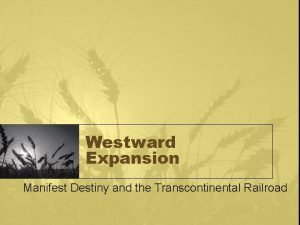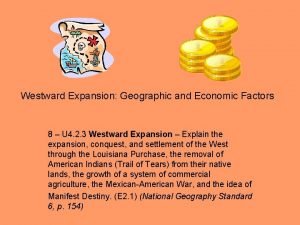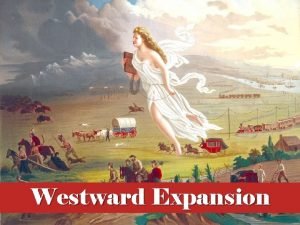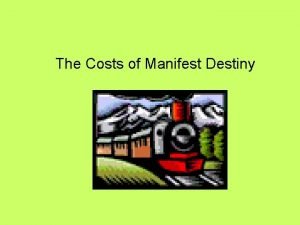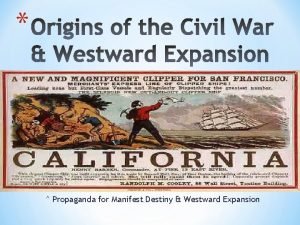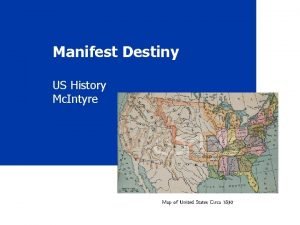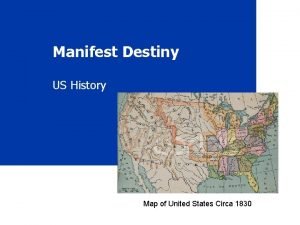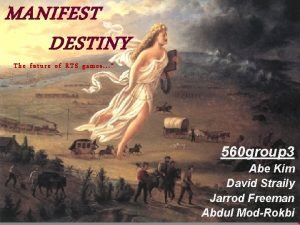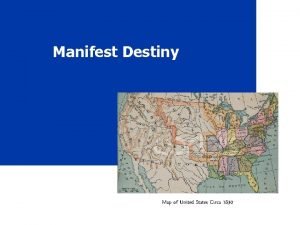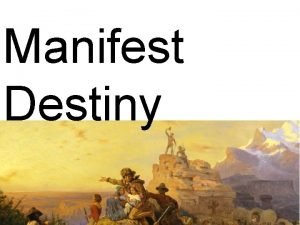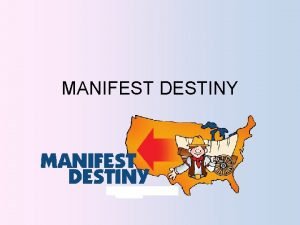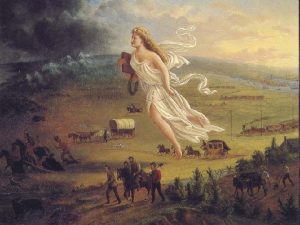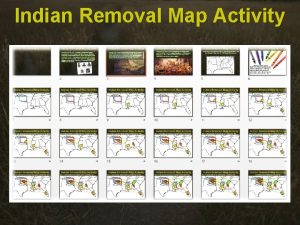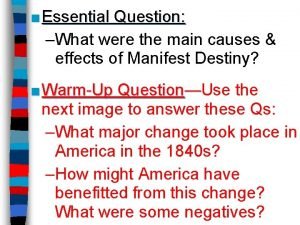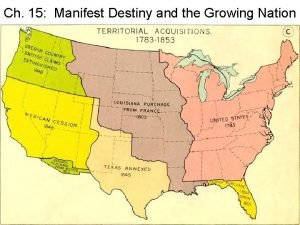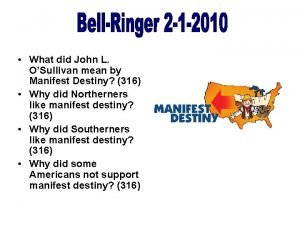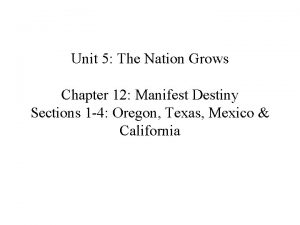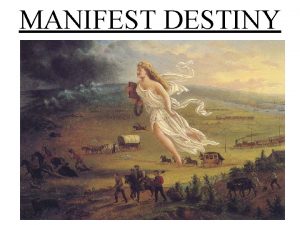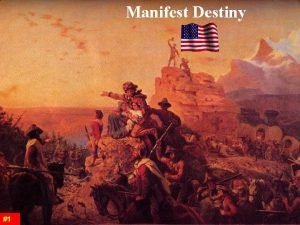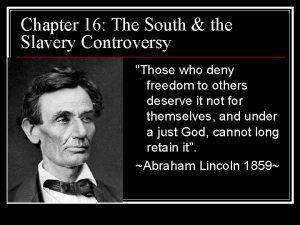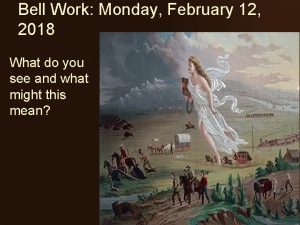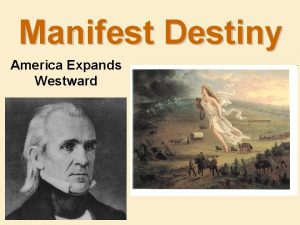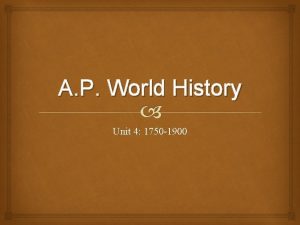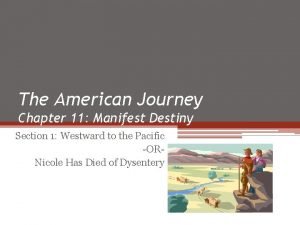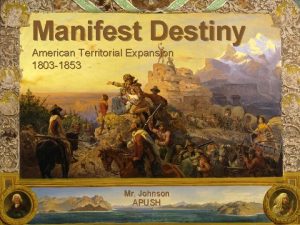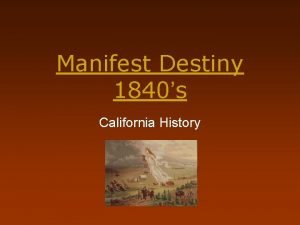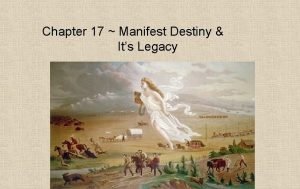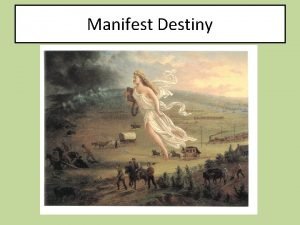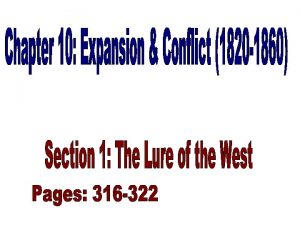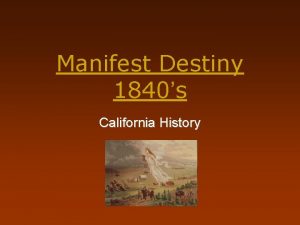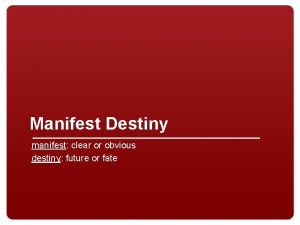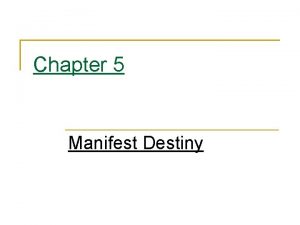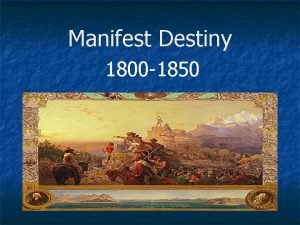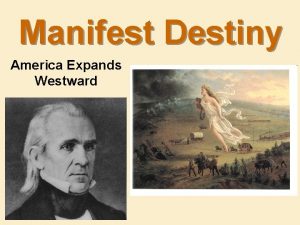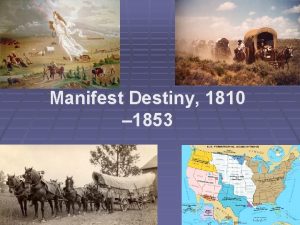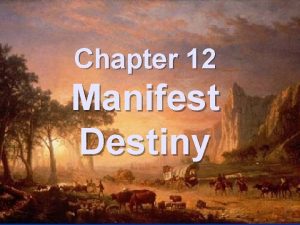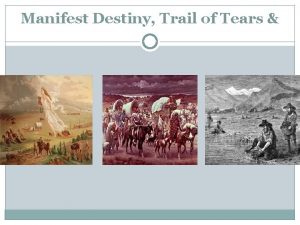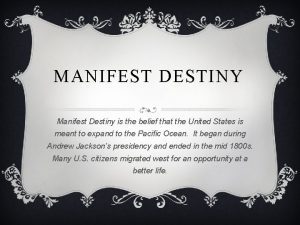Preview Manifest Destiny 6 Complete questions on Preview


































- Slides: 34

Preview: Manifest Destiny #6 Complete questions on Preview page using the chart below: when done work on vocab/I. D

Notes: Manifest Destiny Oregon Territory In the early 1800 s four countries laid claim to the Americas: U. S. , Great Britain, Spain and Russia. After the expeditions of Lewis & Clark, from 1820 to 1860, there was a large mass migration of white Americans moving westward. This “great migration” westward began with the Adams-Onis Treaty. Not only did Spain cede Florida to the U. S. , but they gave up their claim to the Oregon Country as well. #6

Notes: Manifest Destiny Oregon Territory Before the Adams-Onis Treaty, President Adams made an agreement with Great Britain to have joint occupation of the Oregon Country. The first Americans to arrive in the Oregon Country were fur trappers who lived in the mountains. They set up trails and trading posts in the region. #6

Notes: Manifest Destiny Oregon Territory In the 1840 s, the mass migration of Americans to the Oregon Country became known as the “Oregon Fever” Pioneers came in large numbers for free land the dream of building their own fortune in the west. In your own words…… explain the travel and travel route of the Oregon Settlers. #6

Notes: Manifest Destiny Which two groups of people are circled in this image? #6

Notes: Manifest Destiny “Expansion to the Pacific was as inevitable as that the Mississippi should flow to the sea. ” It was a “law of nature. ” John Quincy Adams is holding the common belief that our democracy and way of life are based on God’s natural rights and we should bring that to all of America. #6

Notes: Manifest Destiny The idea that America must expand its borders to the Pacific Ocean because: 1. The nation wanted more land for its growing population. 2. America could bring economic and social prosperity to places in which it never existed before. 3. American territory expansion was blessed by God because it was morally right. #6

Notes: Manifest Destiny Fifty-Four Forty or Fight James Polk would win the 1844 presidency demanding that the U. S. acquire sole possession of the Oregon Territory, up to the 54 th parallel or fight to get that land from Great Britain. When Polk wins the election he does not fight for possession of Oregon, but makes a compromise with Great Britain. In 1845, The border was set at the 49 th parallel (not 54), the present day border with Canada today. #6

Notes: Manifest Destiny Texas Independence (p. 362 -367) In the early 1800 s few people lived in Mexican controlled Texas. Americans move to Mexico for free land—Mexico gave large tracts of land away to settlers. By 1830, there were more Americans than Mexicans in Mexico because of the land policy. In response to the large numbers of white settlers, Mexico then stopped American immigration and banned slavery. Texans of American descent were angered by the new policies of Mexico. #6

Notes: Manifest Destiny Texas Independence (p. 362 -367) In 1835, Americans overthrew the Mexican government in San Antonio Texas. The response by Mexico was the battle of the Alamo. Mexico won but the battle became a rally cry for Texas Independence, “Remember the Alamo. ” In late 1836, Sam Houston, president of the new Republic of Texas, asked President Jackson to annex Texas— Jackson refused. Lone Star State Without the help of the U. S. the Americans in Texas were forced to continue fighting for their independence against Mexico alone. #6

Notes: Manifest Destiny War with Mexico (p. 369 -374) In 1821 After the Adams-Onis Treaty, California and Mexico went from Spanish control to Mexican control. Conflict over California was directly related to the problem in Texas. The U. S. made an offer to purchase both Texas and California. In 1845, the U. S. annexed Texas and California and a border dispute arose between the U. S. and Mexico over Texas. In 1846, Congress declared war on Mexico. #6

Notes: Manifest Destiny War with Mexico (p. 369 -374) President Polk had three war goals: (1) Fight for control of Texas (2) Fight for control of New Mexico and California (3) capture Mexico City. The war ended with all three goals being accomplished. The Treaty of Guadalupe was signed. Mexico gives up Texas, California, and New Mexico (Mexican Cession). They also later sell an area on the Sothern border of Arizona/N. M. (Gadsden Purchase). Immediately following the war with Mexico, the 49’ California Gold Rush would then occur and boomtowns would develop across the #6

Notes: Manifest Destiny Go to notes. Finish this Map. Then work on vocab/I. D Areas acquired in 1821 After the Adams-Onis Treaty with Spain Areas acquired from wars with Mexico (Texas Independence, Mexican American War) #6

Notes: Manifest Destiny #6 Gold Rush After the war with Mexico ended, the 49’ California Gold Rush would begin and boomtowns would develop across the west over the next decade and throughout the 1800 s as Americans would seek their fortunes. gold rush boom towns

Notes: Manifest Destiny #11 Manifest Destiny and Native Americans Most Native Americans would migrate away from white settlements Native Americans would not organize their resistance until after the Civil War

Notes: Manifest Destiny The Telegraph Samuel Morse invented the telegraph in 1844. The U. S. telegraph network was controlled by Western Union. At telegraph offices, operators sent instant messages around the U. S. in Morse Code. Shopkeepers relied on the telegraph to order goods; reporters used them to transmit stories to newspapers. Americans also began sending their personal messages through the telegraph. With the telegraph, the West was not so far removed from the Eastern U. S. . 1866, Cyrus Field lays telegraph across Atlantic Ocean. #6

Notes: Manifest Destiny Transcontinental Railroad The Transcontinental Railroad was completed in 1869. Driving the Golden Spike Completion of the Transcontinental Railroad #6

Conclusion: Manifest Destiny #6 American Progress What does the painting describe about Manifest Destiny? Seeking Land Progress What does the angel symbolize? What does the sky symbolize? What is the effect of American Progress?

I. Preview: How does this image describe America’s Manifest Destiny? Manifest Destiny 1. 2. 3. Land#11 Progress Blessed by God

II. What are the negative effects to the West caused by Preview: Manifest Destiny? Manifest Destiny #11

Preview: Economies of the North & South 1. How many miles of railroads does the North have in 1840 and how many does the South have in 1840? 2. How many miles of railroads does the North have in 1860 and how many does the South have in 1860? 3. Compare and Contrast the growth of railroads. a) Do the railroads grow in both north and south? Do they grow at the same rate? b) Which region has an transportation advantage? Why do you think this advantage is important to a regions economy? #7 When finished work on notes. Beginning on pg. 306

Notes: Economies of the North & South #7 Introduction The Industrial Revolution began to take root in the United States around 1800 in New England. North: Growth of Industry • Textiles (woven cloth/fabric) were the largest industry in the industrialized North. • The textile boom (in the U. S. ) was caused by the invention of the Cotton Gin, a machine that would clean cotton. • The new factories were powered by water, later by coal. • Many farmers moved to the cities to find jobs in the factories, joining immigrant laborers.

Notes: Economies of the North & South #7

Notes: Economies of the North & South #7 North: Growth of Industry • Textiles were the largest industry in the industrialized North. • The textile boom (in the U. S. ) was caused by the invention of the Cotton Gin, a machine that would clean cotton. • The new factories were powered by water, later by coal. • Many farmers moved to the cities to find jobs in the factories, joining immigrant laborers. • Capitalism is an economy based on private property and free enterprise. • Capital is the money and labor needed to run a business. • Free Enterprise is an economic system with little government intervention in the freedom of business to earn a profit.

Notes: Economies of the North & South North: Growth of Industry • Many people moved to the cities to find jobs in the factories, joining immigrant laborers. • Capitalism is an economy based on private property and free enterprise. • Capital is the money and labor needed to run a business. • Free Enterprise is an economic system with little government intervention in the freedom of business to earn a profit. #7

Notes: Economies of the North & South North: Industrialization Three Phases of the Industrial Revolution* 1. Specialized Labor—each person has a particular job to do. 2. Specialized Factories— each factory produces a single product. 3. Mechanized Factories— machines begin replacing the work of people in factories. #7

Notes: Economies of the North & South North: Improved Transportation Because of the rise of factories an improved transportation system was built. 1. Railroads—the network of railroads was twice as large in the North. 2. Steamboats—the network of canals was more than four times that of the South. 3. Clipper Ships—largely controlled by New England companies to ship both Northern and Southern goods to Europe. #7

Notes: Economies of the North & South: Growth of Industry The invention of the cotton gin started the industrialization of the textile industry in England the New England United States. The demand for southern cotton increased as the Northern Factories increased. The demand for slaves increased as the cotton production increased. #7

Notes: Economies of the North & South • The south lacked capital. Most all of the banks were in the north. • The south was too dependent on cotton production. Since they were making money on cotton, plantation owners did not diversify and industrialize. #7

Notes: Economies of the North & South #7 South: Types of Farms Unlike the North, the South remained overwhelmingly rural with farming as the main source of wealth. 1. Small Farms—most Southerners lived on small farms, They were the rural poor, but owned their land. (called Yeoman) 2. Tennant Farmer—Rented their land shared their proceeds with their landlord. 3. Plantations—large farm, often using slave labor, often growing a single cash crop. Plantations • • The plantation was a business of producing a cash crop for a profit. Slaves were an inexpensive form of labor, allowing the plantation to earn a greater profit. Slaves worked as field hands, very few worked as house servants. Slaves were managed by an overseer.

Conclusion: Economies of the North & South #7 Compare the economies of the North and South. Use the following words: Factory, Plantation, Labor, Slaves, Capital, Transportation

Notes: Economies of the North & South #7 Read Slide and Take Notes, #12 (or look in textbook) South: Growth of Industry The invention of the cotton gin started the industrialization of the textile industry in the North. The demand for southern cotton increased as the Northern textile factories increased. The demand for slaves increased as the cotton production increased. Very little industrial development in the south—the south lacked capital. Most all of the banks were in the north and loaned to northern businesses. The south was too dependent on cotton production. Since they were making money on cotton, plantation owners did not diversify and industrialize. As a result, transportation improvements did not come as rapidly as in the North. South: Types of Farms Unlike the North, the South remained mostly rural with farming as the main source of wealth. 1. Small Farms—most Southerners lived on small farms. While poor, they owned their own land. (they were called Yeoman) 2. Tennant Farmer—Rented their land shared their proceeds with their landlord (lower in social class than Yeoman). 3. Plantations—large farm, often using slave labor, often growing a single cash crop. When South: Plantations The plantation was a business of producing a cash crop for a profit. Slaves were an inexpensive form of labor, allowing the plantation to earn a greater profit. Slaves worked as field hands, very few worked as house servants. Slaves were managed by an overseer. finished, ask for Test Review

Notes: Economies of the North & South: Plantations • The plantation was a business of producing a cash crop for a profit. • Slaves were an inexpensive form of labor, allowing the plantation to earn a greater profit. • Slaves worked as field hands, very few worked as house servants. • Slaves were managed by an overseer. # 12

Conclusion: Economies of the North & South How was the U. S. becoming sectional based on the economies of the North and South? Why do you think that the North would be better prepared for war based on their economy? #12
 Transcontinental railroad manifest destiny
Transcontinental railroad manifest destiny Reasons for manifest destiny
Reasons for manifest destiny Westward expansion discussion questions
Westward expansion discussion questions Costs of manifest destiny
Costs of manifest destiny Westward expansion propaganda
Westward expansion propaganda Manifest destiny map
Manifest destiny map Manifest destiny map with dates
Manifest destiny map with dates Rts manifest
Rts manifest United states map 1830
United states map 1830 Growth of the united states to 1853
Growth of the united states to 1853 Gadsden purchase definition
Gadsden purchase definition Chapter 9 section 2 manifest destiny answer key
Chapter 9 section 2 manifest destiny answer key Manifest destiny book
Manifest destiny book Trail of tears map activity
Trail of tears map activity Reason for manifest destiny
Reason for manifest destiny Poem on sports
Poem on sports Manifest destiny apush
Manifest destiny apush Manifest destiny and the growing nation
Manifest destiny and the growing nation Travel in a growing nation answer key
Travel in a growing nation answer key Manifest destiny apush
Manifest destiny apush John l osullivan
John l osullivan Chapter 12 manifest destiny
Chapter 12 manifest destiny Gadsden purchase jimmy fallon
Gadsden purchase jimmy fallon Manifest destiny effect
Manifest destiny effect Whats the definition of manifest destiny
Whats the definition of manifest destiny Manifest destiny
Manifest destiny Manifest destiny
Manifest destiny Monroe doctrine and manifest destiny
Monroe doctrine and manifest destiny Manifest destiny
Manifest destiny How does this painting represent manifest destiny?
How does this painting represent manifest destiny? Define manifest destiny in your own words.
Define manifest destiny in your own words. Chapter 17 manifest destiny and its legacy
Chapter 17 manifest destiny and its legacy Manifest destiny era
Manifest destiny era Manifest
Manifest Mexican cession map
Mexican cession map
